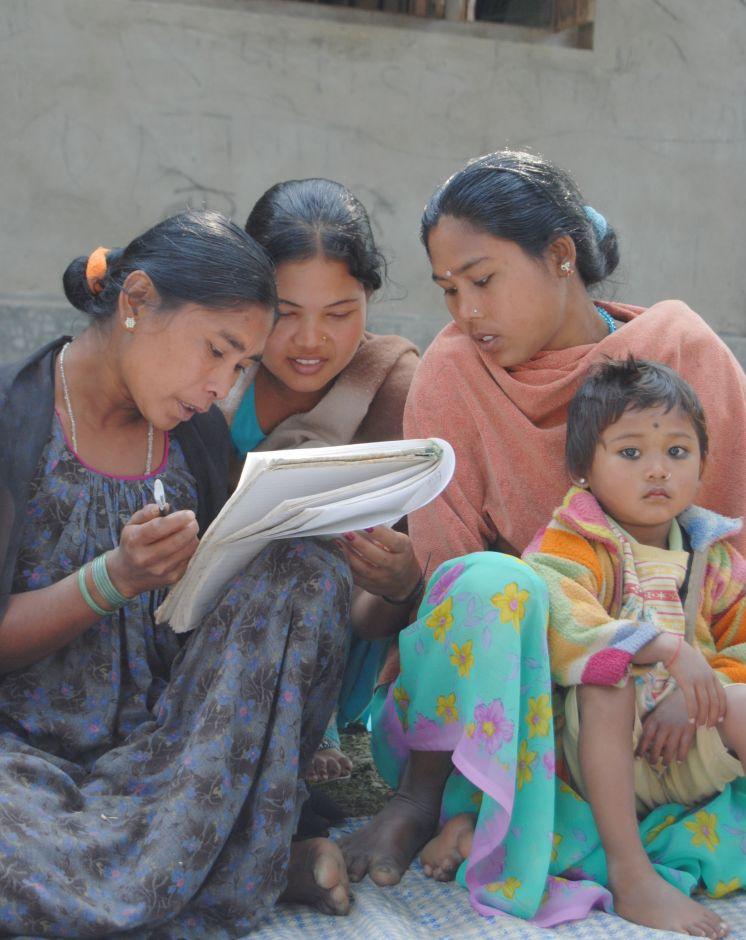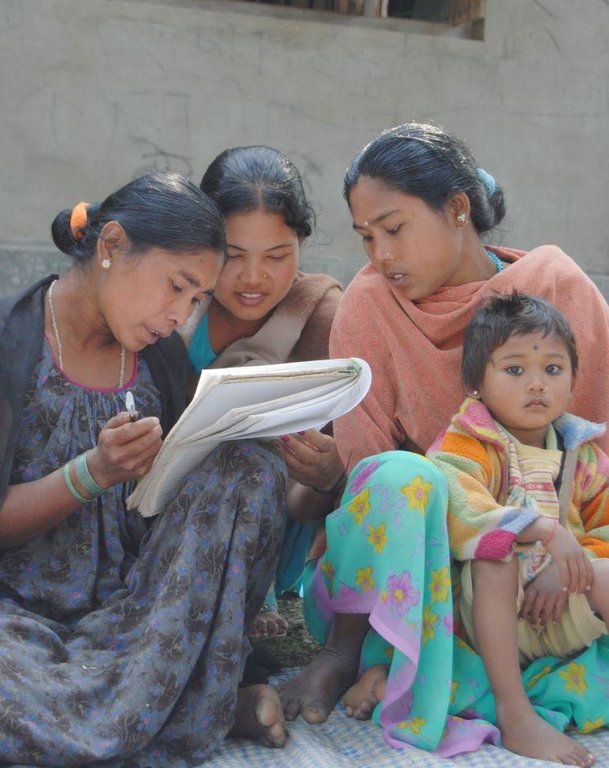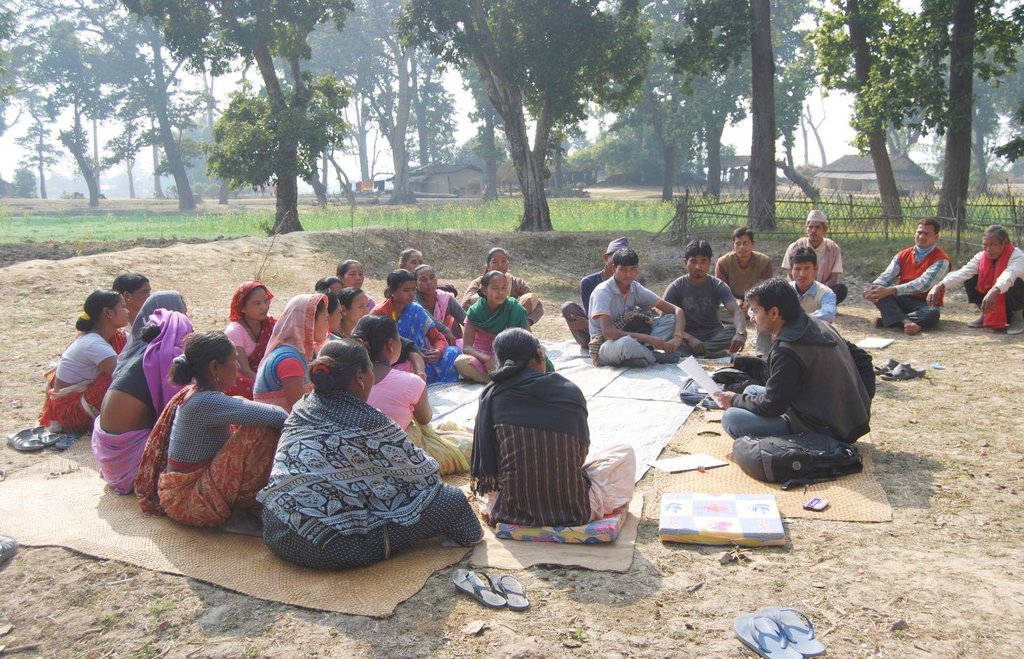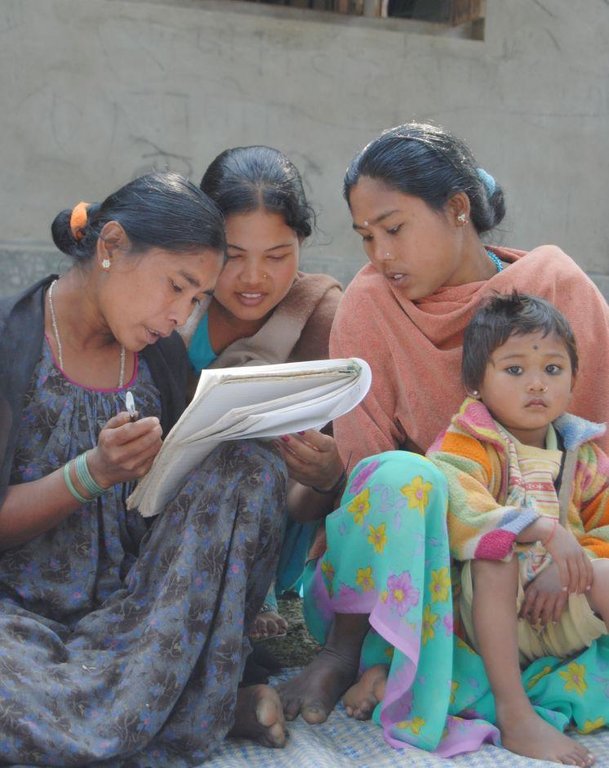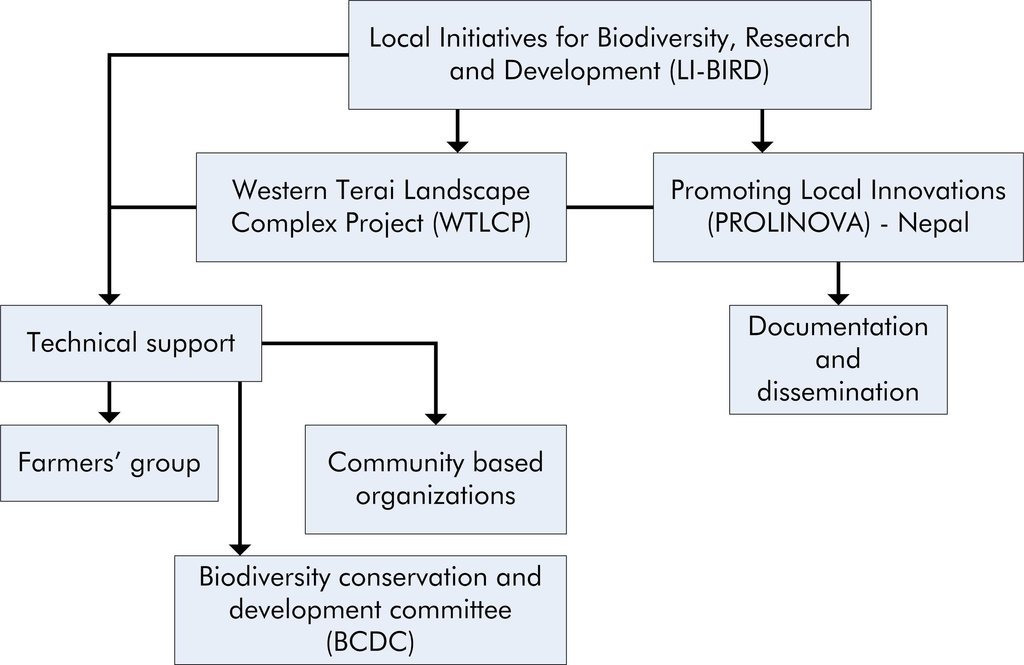Learning about no-till methods through farmer-to-farmer dissemination [Népal]
- Création :
- Mise à jour :
- Compilateur : Shreedip Sigdel
- Rédacteur : –
- Examinateur : Fabian Ottiger
Kisan - Kisan bichko prasal dwara khanjot nagarikana kheti garne tarika ko addhyan (Main Contributor: Krishna Lamsal, LI-BIRD)
approaches_2531 - Népal
Voir les sections
Développer tout Réduire tout1. Informations générales
1.2 Coordonnées des personnes-ressources et des institutions impliquées dans l'évaluation et la documentation de l'Approche
Spécialiste GDT:
Spécialiste GDT:
Lamsal Krishan
+977 61 5535357/5526834 / 9841483937 (M)
naturekrish@gmail.com / klamsal@libird.org,
Local Initiatives for Biodiversity, Research and Development (LI-BIRD)
P.O.Box 324, Gairapatan, Pokhara
Népal
Nom du ou des institutions qui ont facilité la documentation/ l'évaluation de l'Approche (si pertinent)
ICIMOD International Centre for Integrated Mountain Development (ICIMOD) - NépalNom du ou des institutions qui ont facilité la documentation/ l'évaluation de l'Approche (si pertinent)
Kathmandu University (KU) - NépalNom du ou des institutions qui ont facilité la documentation/ l'évaluation de l'Approche (si pertinent)
Local Initiatives for Biodiversity, Research, and Development (LI-BIRD) - Népal1.3 Conditions relatives à l'utilisation par WOCAT des données documentées
Quand les données ont-elles été compilées (sur le terrain)?
01/03/2013
Le compilateur et la(les) personne(s) ressource(s) acceptent les conditions relatives à l'utilisation par WOCAT des données documentées:
Oui
1.4 Références au(x) questionnaire(s) sur les Technologies de GDT
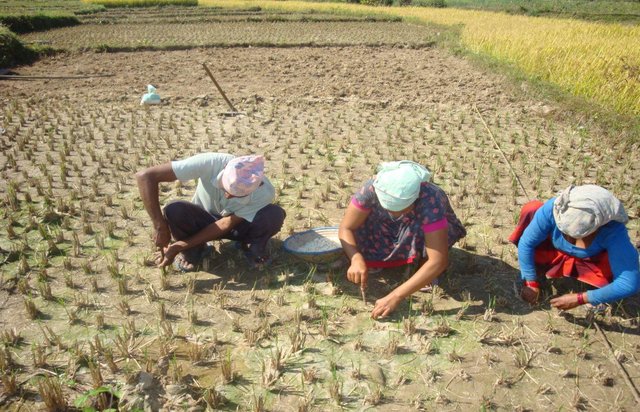
No-till garlic cultivation [Népal]
No-till is a farming system in which the seeds are planted directly into untilled soil which still contains the previous crop residues. No-till cultivation of garlic is practiced in the tropical lowland districts of western Nepal where garlic is sown directly into the soil after the paddy is harvested.
- Compilateur : Shreedip Sigdel
2. Description de l'Approche de GDT
2.1 Courte description de l'Approche
Farmer to farmer dissemination of information on no-till methods for garlic cultivation technology
2.2 Description détaillée de l'Approche
Description détaillée de l'Approche:
Aims / objectives: Farmers can learn about alternative or newer methods by sharing their experiences with one another. In this approach, farmers shared information and knowledge on no-till garlic cultivation technology.
Methods: Since no-till methods are not widely known in the area, the approach aimed to increase awareness of the many features of the technique and its benefits. Through farmer-to-farmer dissemination, communities can learn about the various aspects of no-till for crop residue management, resource use, and how it can reduce labour costs. These discussions highlight the environmental and social benefits of no-till methods especially with respect to moisture retention, soil and water conservation, and climate change adaptation.
In 2009, Local Initiatives for Biodiversity, Research, and Development (LI-BIRD), piloted and validated no-till farming in Nepal as a measure for soil and water conservation through the Western Terai Landscape Complex Project (WTLCP) and the Promoting Local Innovation (PROLINNOVA) programme. The dissemination was multi-faceted and the farmers remained engaged throughout the discussions, which included both talks and group participation. Farmers’ groups, community-based organizations, biodiversity conservation groups, and development committees at the village level were given training and technical inputs. This community-level interaction encouraged farmers to discuss with one another as well as to head out to the field for demonstrations and observations. After no-till garlic cultivation was successfully piloted, it was widely adopted by farming communities and especially the indigenous Tharu communities of western Nepal.
2.3 Photos de l'approche
2.5 Pays/ région/ lieux où l'Approche a été appliquée
Pays:
Népal
Autres spécifications du lieu :
Gadariya VDC, Kailali District
2.6 Dates de début et de fin de l'Approche
Indiquez l'année de démarrage:
10
2.7 Type d'Approche
- initiative/ innovation récente locale
2.8 Principaux objectifs de l'Approche
The Approach focused mainly on SLM with other activities (agricultural and livelihood related technology)
• To disseminate information and know-how on no-till methods
• To increase awareness among the farmers on the benefits of no-till methods and crop residue management
• To increase awareness of the environmental and social benefits of no-till methods and the role that it can play in adaptation to climate change
The SLM Approach addressed the following problems: • Lack of awareness about low cost soil and water conservation technologies that address farmers' needs
• Initially there was weak institutional support for organizing discussion sessions
2.9 Conditions favorisant ou entravant la mise en œuvre de la(des) Technologie(s) appliquée(s) sous l'Approche
normes et valeurs sociales/ culturelles/ religieuses
- entrave
No-till methods are not widely known in the area
Treatment through the SLM Approach: The group was readily convinced of the economic benefits of no-till methods (especially for garlic production) and this was essential in persuading them to accept the technology.
disponibilité/ accès aux ressources et services financiers
- entrave
Financial resources lacking; this group does not have links to financial institutions.
Treatment through the SLM Approach: Farmers used their own resources
autre
- entrave
Water availability is poor.
Treatment through the SLM Approach: No-till methods help to conserve moisture in the soil.
3. Participation et rôles des parties prenantes impliquées dans l'Approche
3.1 Parties prenantes impliquées dans l'Approche et rôles
- exploitants locaux des terres / communautés locales
Community based organization, farmers group
About 60% of those who attend meetings are women. Most of the field activities such as planting and harvesting are performed by women. The indigenous Tharu communities are adopting this technology.
- ONG
LI-BIRD
3.2 Participation des exploitants locaux des terres/ communautés locales aux différentes phases de l'Approche
| Participation des exploitants locaux des terres/ communautés locales | Spécifiez qui était impliqué et décrivez les activités | |
|---|---|---|
| initiation/ motivation | auto-mobilisation | Community meetings organized to discuss the new technology and how it could be implemented locally |
| planification | interactive | Interactive discussion groups and focal groups organized in the community |
| mise en œuvre | auto-mobilisation | Individual farmers implemented the technology on their land without external support. LI-BIRD provided in-kind and technical information and support. |
| suivi/ évaluation | auto-mobilisation | LI-BIRD monitored the implementation of the technology and helped to evaluate the outcome. They collected and analysed data in order to highlight the soil and water conservation aspects of the no-till method and disseminated this information. |
| Research | aucun |
3.3 Diagramme/ organigramme (si disponible)
Description:
LI-BIRD piloted and validated no-till farming in Nepal as a measure for soil and water conservation through the Western Terai Landscape Complex Project (WTLCP) and the Promoting Local Innovation (PROLINNOVA) programme. Technical support was extended to farmers’ groups, community-based organizations, biodiversity conservation groups, and development committees at the village level.
Auteur:
(A. K. Thaku)
3.4 Prises de décision pour la sélection de la Technologie/ des Technologies
Indiquez qui a décidé de la sélection de la Technologie/ des Technologies à mettre en œuvre:
- principalement les exploitants des terres soutenus par des spécialistes de la GDT
Expliquez:
Decisions on the method of implementing the SLM Technology were made by mainly by land users supported by SLM specialists
4. Soutien technique, renforcement des capacités et gestion des connaissances
4.1 Renforcement des capacités/ formation
Une formation a-t-elle été dispensée aux exploitants des terres/ autres parties prenantes?
Oui
Spécifiez qui a été formé:
- exploitants des terres
Si pertinent, spécifiez le genre, l'âge, le statut, l'ethnie, etc.
Land users and community mobilizers from the indigenous Tharu communities were given training on no-till method and crop residue management.
Formats de la formation:
- zones de démonstration
Formats de la formation:
- Participatory methods and approaches
4.2 Service de conseils
Les exploitants des terres ont-ils accès à un service de conseils?
Oui
Spécifiez si le service de conseils est fourni:
- dans des centres permanents
Décrivez/ commentez:
Name of method used for advisory service: Capacity building training; Key elements: Capacity building took place through site visits and extension materials as well as through discussions and exchanges
4.3 Renforcement des institutions (développement organisationnel)
Des institutions ont elles été mises en place ou renforcées par le biais de l'Approche?
- oui, modérément
Spécifiez à quel(s) niveau(x), ces institutions ont été renforcées ou mises en place:
- local
Précisez le type de soutien:
- renforcement des capacités/ formation
- Technical support
Donnez plus de détails:
LI-BIRD supported farmers groups, biodiversity conservation and development committees, and community-based organizations by providing hands-on training and technical support.
4.4 Suivi et évaluation
Le suivi et l'évaluation font ils partie de l'Approche? :
Oui
Commentaires:
technical aspects were regular monitored by project staff, government, land users through observations; indicators: Regular observations by technical staff from LI-BIRD jointly with representatives from biodiversity conservation and development committees, farmers groups, and community-based organizations
socio-cultural aspects were regular monitored by project staff, land users through observations; indicators: Regular observations by technical staff from LI-BIRD jointly with representatives from biodiversity conservation and development committees, farmers groups, and community-based organizations
economic / production aspects were regular monitored by project staff, government, land users through observations
economic / production aspects were monitored by None through measurement
There were several changes in the Approach as a result of monitoring and evaluation: Several changes were observed. People learned both through discussions and by taking a hands-on approach. An initial attempt to replicate the method ended in failure. However, through discussions and technical inputs, the farmers were eventually able to replicate the method and it is now well understood.
5. Financement et soutien matériel externe
5.1 Budget annuel de la composante GDT de l'Approche
Commentez (par ex. principales sources de financement/ principaux bailleurs de fonds):
Approach costs were met by the following donors: local community / land user(s) (Mostly by the land users; capacity building activities and field demonstration costs were borne by LI-BIRD.): 100.0%
5.2 Soutiens financiers/ matériels fournis aux exploitants des terres
Les exploitants des terres ont-ils reçu un soutien financier/ matériel pour la mise en œuvre de la Technologie/ des Technologies?
Non
5.3 Subventions pour des intrants spécifiques (incluant la main d'œuvre)
- aucun
5.4 Crédits
Des crédits ont-ils été alloués à travers l'Approche pour les activités de GDT?
Non
6. Analyses d'impact et conclusions
6.1 Impacts de l'Approche
Est-ce que l'Approche a aidé les exploitants des terres à mettre en œuvre et entretenir les Technologies de GDT?
- Non
- Oui, un peu
- Oui, modérément
- Oui, beaucoup
No-till and better use of crop residues has contributed to improved land management; more moisture is now retained in the soil. Water is in poor supply and vegetable production in this area is limited by the amount of moisture in the soil.
Est-ce que l'Approche a autonomisé les groupes socialement et économiquement défavorisés?
- Non
- Oui, un peu
- Oui, modérément
- Oui, beaucoup
The indigenous Tharu communities now have some increased cash income from selling their garlic crop.
Did other land users / projects adopt the Approach?
- Non
- Oui, un peu
- Oui, modérément
- Oui, beaucoup
Community-based organizations, as well as members of other communities and neighbouring districts, have either adopted the method or expressed an interest in learning how to implement it.
Did the Approach lead to improved livelihoods / human well-being?
- Non
- Oui, un peu
- Oui, modérément
- Oui, beaucoup
Mainly due to increased income from garlic production and reduced labour costs associated with no-till.
Did the Approach help to alleviate poverty?
- Non
- Oui, un peu
- Oui, modérément
- Oui, beaucoup
mainly due to increased income from garlic production and reduced labour costs. Studies showed a 25% increase in crop yield and reduced labour requirements.
6.2 Principale motivation des exploitants des terres pour mettre en œuvre la GDT
- augmenter la rentabilité/ bénéfice, rapport coûts-bénéfices
- réduire la charge de travail
- well-being and livelihoods improvement
6.3 Durabilité des activités de l'Approche
Les exploitants des terres peuvent-ils poursuivre ce qui a été mis en œuvre par le biais de l'Approche (sans soutien extérieur)?
- oui
Si oui, décrivez de quelle manière:
This technology has a high probability of being sustainable because it is cost effective and requires minimal technical input (farmers can do it on their own); moreover, it helps with soil conservation.
6.4 Points forts/ avantages de l'Approche
| Points forts/ avantages/ possibilités du point de vue du compilateur ou d'une autre personne ressource clé |
|---|
| Farmers can easily learn no-till techniques through community participation. The approach is sustainable because it is easy to implement and it appeals to farmers because they appreciate it as a way of reducing labour and increasing crop yields. (How to sustain/ enhance this strength: Continue to give some minor technical support and encouragement.) |
| The approach focused on building capacity by using a hands-on approach similar to how farmers traditionally transfer know-how between themselves. Farmers can adapt and modify the technology as needed to deal with changing conditions in the environment. Financial inputs by external organizations are not needed. (How to sustain/ enhance this strength: Continue to give some minor technical support and encouragement.) |
6.5 Faiblesses/ inconvénients de l'Approche et moyens de les surmonter
| Faiblesses/ inconvénients/ risques du point de vue du compilateur ou d'une autre personne ressource clé | Comment peuvent-ils être surmontés? |
|---|---|
| Market linkages are poor and the scope to scale up is also small. | The establishment of stronger market linkages would motivate farmers to attempt commercial cultivation. |
7. Références et liens
7.1 Méthodes/ sources d'information
- visites de terrain, enquêtes sur le terrain
- interviews/entretiens avec les exploitants des terres
Liens et modules
Développer tout Réduire toutLiens

No-till garlic cultivation [Népal]
No-till is a farming system in which the seeds are planted directly into untilled soil which still contains the previous crop residues. No-till cultivation of garlic is practiced in the tropical lowland districts of western Nepal where garlic is sown directly into the soil after the paddy is harvested.
- Compilateur : Shreedip Sigdel
Modules
Aucun module trouvé


